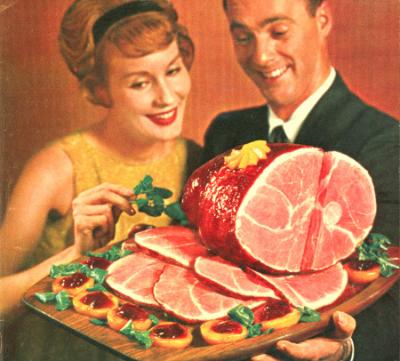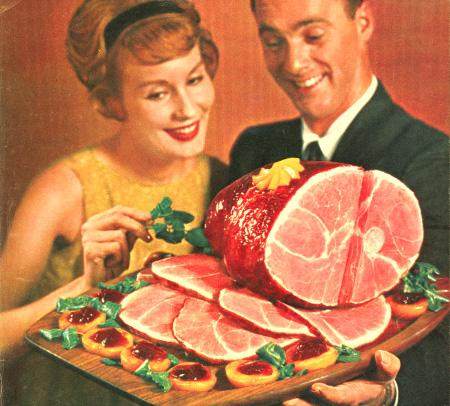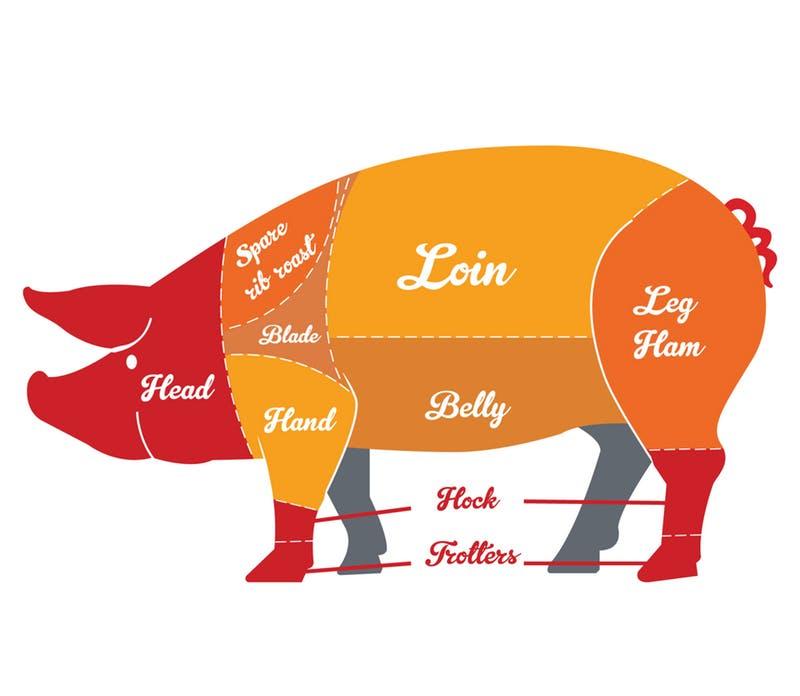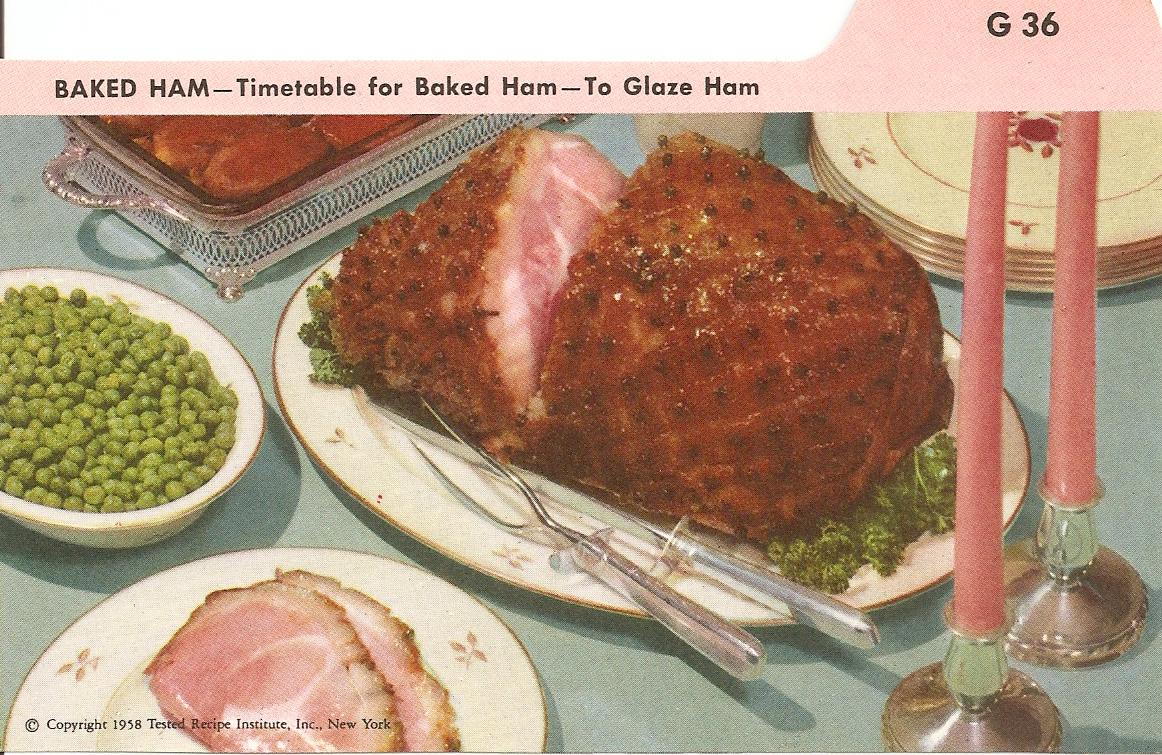Easter is a deeply religious holiday within the Christian faith, commemorating the events leading up to the crucifixion and resurrection of Jesus. Many traditions accompany this spring celebration, such as dye-colored eggs, candy filled rattan baskets, and as with most holidays, an array of specially prepared foods. In North America it’s particularly common to serve ham on Easter Sunday, unlike Europe where lamb is more often the traditional Easter entrée.
Most of us might remember the delightfully kitsch Easter dinner our moms served up; spiraled ham decorated with golden rings of pineapple, each slice topped with a sugary red maraschino cherry. Oh, what sweet memories. The table adorned with pastel colored linens, fresh spring flowers, grandma’s china, and a buffet of family favorite side dishes; all complimenting the familiar smoky, meaty centerpiece – the Easter ham.
Most of us might remember the delightfully kitsch Easter dinner our moms served up; spiraled ham decorated with golden rings of pineapple, each slice topped with a sugary red maraschino cherry. Oh, what sweet memories. The table adorned with pastel colored linens, fresh spring flowers, grandma’s china, and a buffet of family favorite side dishes; all complimenting the familiar smoky, meaty centerpiece – the Easter ham.
For many people the anticipation of eating a plentiful meal centered on a hearty platter of pork was considered a reward for a long season of Lenten fast. Pork has almost always been considered lucky by various groups of people throughout the world and an age-old custom of eating the meat of the pig on festive occasions trickled its way into a multitude of different cultures, remaining to this day a popular choice for holiday meals.
In addition to the widely accepted belief of luck, it made sense that pork might be served on Easter. In past generations refrigeration was limited in comparison to today’s modern appliances. Farmers would traditionally slaughter their livestock in the fall giving time for the meat to cure in a smoke house throughout the winter months. This would produce the well-preserved, succulent pork just in time for spring eating. This made ham an ideal selection for an important celebration like Easter.
Ham, as we know it, comes from the back leg of the pig. There are generally two ways that this portion of the pig is processed, eventually being sold as the familiar packaged ham we see in our grocery stores.
In addition to the widely accepted belief of luck, it made sense that pork might be served on Easter. In past generations refrigeration was limited in comparison to today’s modern appliances. Farmers would traditionally slaughter their livestock in the fall giving time for the meat to cure in a smoke house throughout the winter months. This would produce the well-preserved, succulent pork just in time for spring eating. This made ham an ideal selection for an important celebration like Easter.
Ham, as we know it, comes from the back leg of the pig. There are generally two ways that this portion of the pig is processed, eventually being sold as the familiar packaged ham we see in our grocery stores.
Fresh Ham: this means the pork has not been cured and is not cooked when packaged and sold.
Cured Ham: this means the pork has been preserved or cured through either smoking, salting, or wet-curing. Wet-curing consist of soaking the meat in brine. The pork may be cooked or uncooked when packaged and sold, though most have been cooked, but be sure to check the label for proper preparation instructions.
You may be wondering about the canned ham. A canned ham essentially is made from cooked ham scraps that have been seasoned, salted and compressed into a can. Mid-century menus often included the canned ham, but a fresh or cured ham is really a better choice for flavor, texture, and appearance.
You may have also heard of the terms city ham and country ham.
City Ham: this means the ham has been wet-cured using a brine of water, salt, and a mixture of both sweet and savory flavorings. It is then smoked over a hard wood like hickory producing a subtle smoky richness to the meat. This ham may be pre-sliced or spiral sliced when packaged and purchased and may be eaten cold as well as heated.
Country Ham: this means the ham has been cured with a dry rub, which is a mixture of salt and dry seasonings. This ham is usually uncooked when packaged and purchased. It can be smoked or unsmoked. This type of ham is popular in the Southern United States.
The question of bone in or bone out is really just a matter of preference. Some cooks believe that a bone in ham will retain more of its natural juices and therefore be moister than a boneless ham. But the curing process will most likely produce a flavorful, moist ham from either if cooked properly.
You should be ready now to prepare an Easter Sunday feast staring your very own baked ham, just like mom used to make! Check out this baked, glazed ham recipe card from 1958.
Cured Ham: this means the pork has been preserved or cured through either smoking, salting, or wet-curing. Wet-curing consist of soaking the meat in brine. The pork may be cooked or uncooked when packaged and sold, though most have been cooked, but be sure to check the label for proper preparation instructions.
You may be wondering about the canned ham. A canned ham essentially is made from cooked ham scraps that have been seasoned, salted and compressed into a can. Mid-century menus often included the canned ham, but a fresh or cured ham is really a better choice for flavor, texture, and appearance.
You may have also heard of the terms city ham and country ham.
City Ham: this means the ham has been wet-cured using a brine of water, salt, and a mixture of both sweet and savory flavorings. It is then smoked over a hard wood like hickory producing a subtle smoky richness to the meat. This ham may be pre-sliced or spiral sliced when packaged and purchased and may be eaten cold as well as heated.
Country Ham: this means the ham has been cured with a dry rub, which is a mixture of salt and dry seasonings. This ham is usually uncooked when packaged and purchased. It can be smoked or unsmoked. This type of ham is popular in the Southern United States.
The question of bone in or bone out is really just a matter of preference. Some cooks believe that a bone in ham will retain more of its natural juices and therefore be moister than a boneless ham. But the curing process will most likely produce a flavorful, moist ham from either if cooked properly.
You should be ready now to prepare an Easter Sunday feast staring your very own baked ham, just like mom used to make! Check out this baked, glazed ham recipe card from 1958.
Place an uncooked or “cook before eating” ham (See Index Card G), fat side up, on a rack in a shallow baking pan. (Have ham at room temperature.) Bake in a moderately low oven, 325°, using chart below. About 45 minutes before end of baking time, remove ham from oven. Slit rind with scissor and peel off. If a glaze is desired, proceed as directed below before returning ham to the oven to complete baking.
TO GLAZE HAM: With a sharp knife, make cuts 1/4 inch deep in the fat in a diamond pattern. Stud with whole cloves. Make a paste of 1 1/2 cups firmly packed brown sugar, 3 tablespoons prepared mustard, and a little water; pat over surface. Bake 45 minutes longer; baste frequently with ham fat.
Timetable for Baking Uncooked Ham
Whole Ham
8 to 10 pounds 2 3/4 to 3 hours
10 to 12 pounds 3 to 3 1/2 hours
12 to 15 pounds 3 1/2 to 4 hours
16 to 18 pounds 4 to 4 1/2 hours
Half Ham
5 to 8 pounds 2 1/4 to 3 hours
Picnic
5 to 8 pounds 3 to 4 1/2 hours
You may have noticed that this vintage recipe card mentions the picnic ham. Picnic ham is actually not a true ham, but instead is a cut that comes from the pig’s front legs along with part of the shoulder rather than its hind leg. It is an American specialty and is sometimes referred to as pork shoulder. Because it is smoked it retains a similar flavor to traditional ham. The picnic ham is sometimes served with a barbeque style glaze rather than fruit flavored glazes. This makes it a perfect summertime choice, explaining its name, picnic.
To reproduce the taste of the mid-century childhood Easter ham, use this recipe for pineapple glaze.
Directions
1. Before baking ham, place pineapple slices on ham with toothpicks and place cherries in center of pineapple.
2. In a medium saucepan combine brown sugar and reserved pineapple juice. Mix together and heat for about 5 minutes, until mixture is thick. Pour some of this glaze over the ham about every 15 minutes in the last hour of baking, until all is used.
Though ham is associated with holiday meals, pork is a meat that can be wonderfully enjoyed year round. Pork is high in protein and is an excellent source of many vitamins and minerals, including thiamin, zinc, vitamin B12, vitamin B6, niacin, phosphorus, and iron. To ensure your pork products are of the highest nutritional value be sure to look for meat products farmed through sustainable and humane farming practices free of GMO’s.
Shop local – eat local – this little piggy went to dinner.
TO GLAZE HAM: With a sharp knife, make cuts 1/4 inch deep in the fat in a diamond pattern. Stud with whole cloves. Make a paste of 1 1/2 cups firmly packed brown sugar, 3 tablespoons prepared mustard, and a little water; pat over surface. Bake 45 minutes longer; baste frequently with ham fat.
Timetable for Baking Uncooked Ham
Whole Ham
8 to 10 pounds 2 3/4 to 3 hours
10 to 12 pounds 3 to 3 1/2 hours
12 to 15 pounds 3 1/2 to 4 hours
16 to 18 pounds 4 to 4 1/2 hours
Half Ham
5 to 8 pounds 2 1/4 to 3 hours
Picnic
5 to 8 pounds 3 to 4 1/2 hours
You may have noticed that this vintage recipe card mentions the picnic ham. Picnic ham is actually not a true ham, but instead is a cut that comes from the pig’s front legs along with part of the shoulder rather than its hind leg. It is an American specialty and is sometimes referred to as pork shoulder. Because it is smoked it retains a similar flavor to traditional ham. The picnic ham is sometimes served with a barbeque style glaze rather than fruit flavored glazes. This makes it a perfect summertime choice, explaining its name, picnic.
To reproduce the taste of the mid-century childhood Easter ham, use this recipe for pineapple glaze.
- 1 (15.25 ounce) can sliced pineapple, drained with juice reserved
- 1 (4 ounce) jar maraschino cherries, drained
- 1 cup brown sugar
Directions
1. Before baking ham, place pineapple slices on ham with toothpicks and place cherries in center of pineapple.
2. In a medium saucepan combine brown sugar and reserved pineapple juice. Mix together and heat for about 5 minutes, until mixture is thick. Pour some of this glaze over the ham about every 15 minutes in the last hour of baking, until all is used.
Though ham is associated with holiday meals, pork is a meat that can be wonderfully enjoyed year round. Pork is high in protein and is an excellent source of many vitamins and minerals, including thiamin, zinc, vitamin B12, vitamin B6, niacin, phosphorus, and iron. To ensure your pork products are of the highest nutritional value be sure to look for meat products farmed through sustainable and humane farming practices free of GMO’s.
Shop local – eat local – this little piggy went to dinner.









